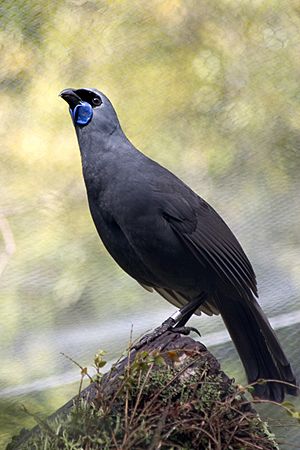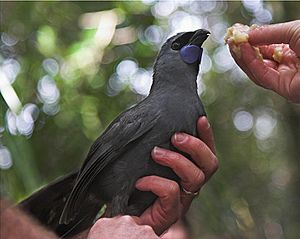North Island kōkako facts for kids
Quick facts for kids North Island kōkako |
|
|---|---|
 |
|
| Conservation status | |
| Scientific classification | |
| Genus: |
Callaeas
|
| Species: |
wilsoni
|
| Synonyms | |
|
C. cinereus wilsoni |
|
The North Island kōkako (Callaeas wilsoni) is a special forest bird. It lives only on the North Island of New Zealand. This bird is grey and has a small black mask around its eyes. It also has bright blue wattles, which are fleshy flaps of skin near its beak. Young kōkako have light pink wattles that turn blue as they get older. People sometimes call it the blue-wattled crow because of these wattles. However, it is not actually a crow. The kōkako is an endangered bird, meaning there are not many left in the wild.
Protecting the Kōkako: Threats and Conservation Efforts

In the early 1900s, the North Island kōkako was common. It lived in many forests across the North Island and its nearby islands. But over time, their numbers dropped a lot. This happened mainly because settlers cleared forests for farms and homes. Also, new animals like rats, stoats, and possums were brought to New Zealand. These animals are predators, meaning they hunt and eat kōkako and their eggs.
Female kōkako are especially at risk. They do all the work of sitting on the eggs and caring for the chicks. This nesting period lasts a long time, about 50 days. During this time, they are easy targets for predators. Because of this, many kōkako populations now have more males than females. This makes it harder for them to have enough babies.
To help the kōkako, the government funds special programs. These programs control pests like rats and stoats. There are also programs to breed kōkako in safe places. Scientists have learned that they can help kōkako populations grow again. They do this by carefully managing the kōkako's forest homes. One helpful method is using a special biodegradable poison called 1080 poison. This poison helps reduce the number of predators. For example, in the Mapara Wildlife Reserve, the number of breeding kōkako grew ten times between 1991 and 1999. This was thanks to using 1080 poison from the air. A new group of kōkako has also been started in the Otanewainuku Forest in the Bay of Plenty.
New kōkako groups are also being started on islands where there are no predators. Conservationists are hopeful that the kōkako will survive for a long time.
Where Kōkako Live: Distribution and Sightings
As of 2010, North Island kōkako could be found in several forests. These include Pureora Forest Park, Whirinaki Te Pua-a-Tāne Conservation Park, Mapara Wildlife Reserve, and the Hunua Ranges. They also live in Ngapukeriki, Kaharoa Forest, the Te Urewera National Park, Puketi Forest, the Waitākere Ranges, and the Waima/Waipoua Forests in Northland.
You can often see kōkako on certain offshore island sanctuaries. These include Tiritiri Matangi and Kapiti Island. The trees on these islands are not too tall, so it's easier to get a good view of the birds. If you want to see a kōkako up close, you can visit a captive bird at the Pukaha / Mount Bruce National Wildlife Centre.


